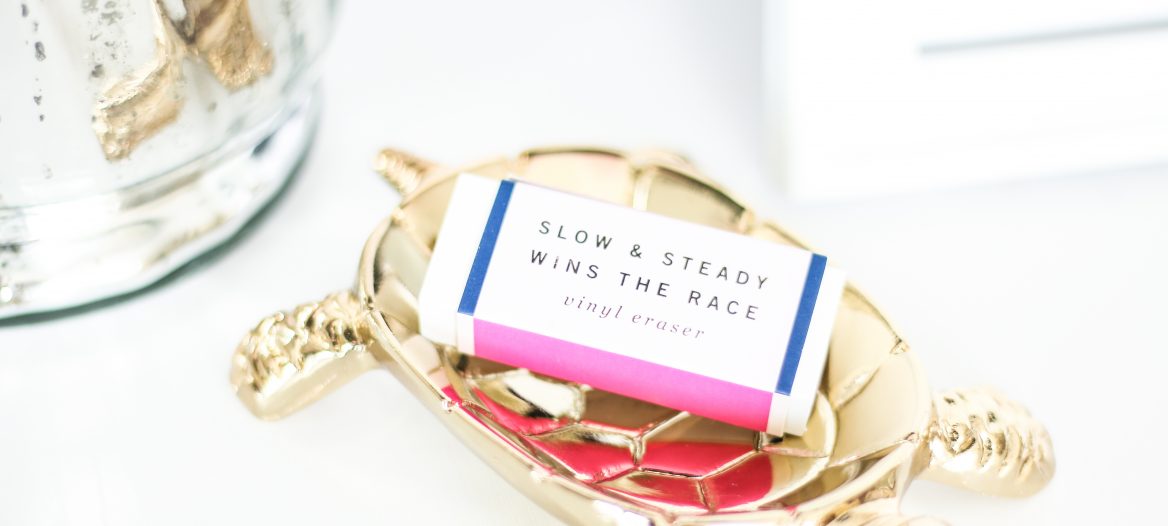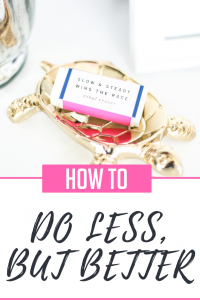How To Do Less But Better

For a while now, the idea of ‘time management’ has been a thing. Quite a big thing. There’s a whole industry based on the idea that we can ‘manage time’, but time is not really a manageable asset. Time is what it is. There are 24 hours of it in a day. 365 days in most years. About 70–80 years in most lifetimes (if you’re lucky). Time can be used wisely or badly, but it can’t really be managed, at least not in the way many of us understand the term time management.
At the crux of most time constraint problems is the idea that there are too many things to do and too little time to do them in. So, understandably, most time management strategies focus on doing more things in less time. But there’s a perfectly viable alternative. We could do less things, in more time. And we’d probably do them better.

Disclosure: Sometimes my work here (and all around the web) contains affiliate links. Find out what that means here.
From time management to productivity
The idea of ‘time management’ has slowly been replaced with the idea of ‘productivity’, but along the way, the two of them have become confused. A colleague will tell you he has been ‘super productive’ today, proudly flourishing a long to-do list with every item ticked off, but has he? Has he really been ‘productive’?
Productivity isn’t actually about doing stuff. It’s about producing stuff. The clue is right there in the word. So we should be measuring productivity in terms of what we produce, not what we do. It’s possible to be doing things all day, without producing a single thing.
As a writer, I’ve had a productive day if I’ve added to my body of work, if I’ve created a new piece of writing, or added a lot of words to an ongoing writing project. If I’ve crossed 100 things off my to-do list and not created anything new, that wasn’t a productive day. As a writer, it’s also hugely tempting for me to measure productivity in terms of quantity, rather than quality, and that is what I’m trying to change.
Word count is everything when you write for a living. Every commissioned piece or agency assignment comes with a word count. We track how many words we write in a week, and celebrate passing the 10,000 words mark with a little happy dance and a glass of red. But writing 5000 words of crap isn’t the same as writing 1000 words of beautiful, meaningful prose. We writers, artists, and other creatives could probably do the world more of a service if we decided to do less, but better.
I’m on a ‘do less, but better’ quest this year. I’m mostly failing right now. I’m a working freelance writer with bills to pay, so I wrote about 12,000 words last week, and they weren’t exactly To Kill A Mockingbird. They were mostly web content and sales pages and blog posts, and they were perfectly good versions of what they were, but that’s all they were. I wish I’d written one perfect 2000 word piece that had somehow changed the world, but I didn’t.
Doing less isn’t as easy as it sounds. Especially in a culture that respects volume, worships long hours, and sanctifies busyness. Our culture glorifies doing more, so that’s what we do, and I suspect the situation is steadily getting out of hand.
Social media isn’t helping. Our fear of missing out has an acronym now. And a hashtag. #FOMO brought up 375,388 posts on Instagram the day I wrote this. And if you’re genuinely anxious that you’re missing out, know what you’re going to try and do? More. More networking. More climbing the corporate ladder. More socialising. More work. More hours (especially if you’re paid by the hour). More words (if, like me, you’re paid by the word).
The fact that #FOMO is a heavily-used hashtag is indicative of how social media, and technology in general, pulls our attention from what we’re doing to what we could be doing instead. As our tech distracts us more and more, our brain becomes like a troupe of monkeys. Jumping back and forth, swinging from one thought to another, never really sitting still and getting something worthwhile done. We fall victim to shiny object syndrome, always chasing the next idea or opportunity, or maybe the next relationship or social gathering. We do more stuff, often in a more sloppy, half-hearted, unfocused way.

Shiny object syndrome has always been a thing, but it works in perfect harmony with the high tech world, and in particular with online algorithms. Google one work-at-home opportunity, dating site, or writing prompt app, and you’ll suddenly have a lot more thrown in front of you, in the form of carefully targeted online ads. So you end up signing up for four online courses, dating apps or MLM opportunities, instead of putting your time and energy into the best or most appropriate one for you right now.
Yep, we’re all doing more, but we’re not all doing better. I, for one, want to change that. Here’s what I’m aiming for:
· Less writing produced, but better quality.
· Fewer freelance clients, but higher paying ones.
· Less time on social media, but better engagement and connection.
· Fewer friendships, but better friends.
· Fewer commitments, but more fulfilling ones.
· Less time spent working out, with better results.
· Fewer creative projects on the go, more true creativity.
· Less time spent working, but better work produced.
· Less time spent worrying, but better solutions reached.
There are some really good reasons to do less, in almost every area of your life. Here are just a few of them.
The law of diminishing returns
We make wildly inaccurate assumptions around whether we’re actually accomplishing more when we work more hours. On a small scale, of course we are. We write more in an hour than we do in ten minutes. But do we accomplish more when we work a 60 hour week rather than a 40 hour week? Probably not.
Henry Ford is credited with the revolutionary idea of giving workers weekends off. He’s often held up as a champion of workers’ rights, but Ford advocating for shorter working hours was actually a result of research, and findings, on the law of diminishing returns.
Ford found that 40 hours a week was the optimal time workers should be working to ensure high levels of productivity, and that working beyond that amount of time, resulted in ‘diminishing returns’ or less work being produced per hour. And that was based on repetitive, assembly line work. If your work is creative, and requires periods of reflection and deep thinking time, it’s probably a lot less. We work best when we build in time to recover. Top Medium writer and author, Benjamin Hardy, wisely gives this counter-intuitive snippet of advice:
“For best results: Spend 20% of your energy on your work and 80% of your energy on recovery and self-improvement.”
Which ties in (very loosely) to my next point.
The 80/20 rule
You’ve probably heard of the 80/20 rule, otherwise known as the Pareto principle, after the Italian economist, Vilfredo Pareto, who realized, back in 1897, that 80% of Italy’s wealth was owned by 20% of its citizens. No doubt this was a revolutionary discovery in 1897, which of course, is no longer surprising or accurate in a world where everyone has become painfully aware that the majority of wealth is always owned by the minority of the people.
The 80/20 rule isn’t really about an 80/20 ratio. The ratio varies, often showing up as 90/10 or 95/5, and of course it doesn’t have to add up to 100 at all. 1% of movies account for 80% of box office takings, and about 7% of websites receive about 80% of worldwide web traffic, meaning ratios of 80/1 or 80/7 are also possible.
These days the 80/20 rule is most often referenced in relation to the fact that, in every area of life and business, the minority of our efforts produce the majority of our results. 1 of my 10 ebooks accounts for most of my sales. 3 of my 100+ blog posts attract most of my traffic. My 3 top-performing stories on Medium are responsible for the majority of my traffic, followers, and revenue on the platform.
The problem with Pareto’s principle is that it’s hard to game, or outmanoeuvre. You genuinely don’t know, until you publish, which books, blog posts or stories are going to gain the most traction. You don’t know until you launch, which creative project is going to bring in most of your revenue, but once you do know, you can certainly try and manipulate things a little.
To go back to my list above, if I get most of my revenue from one writing platform, magazine or publication, I should keep producing work for that platform, magazine or publication, at least for now. If one of my clients pays more than the others, I should pitch that client more ideas. If I get more joy and inspiration hanging out with just two or three of the people I know than all the others put together, I should hang out with them more. If there’s an intensive, ten-minute, daily strength training routine that claims to work better than an hour at the gym, I should give that a try.
I don’t know if you can ever cheat the 80/20 rule, but I know you can use it to do a little bit less, a little bit better.

The evils of multi-tasking
Part of doing less but better is the simple act of doing one thing at a time, preferably to the completion of one particular creative project (yes, creative people, I’m suggesting you complete one project before starting another, rather than working on 5 at once — crazy idea, right?).
Twenty-first century humans tend to multitask, a lot. We see multitasking as desirable, and essential. We roll our eyes at the guy who can’t cook dinner while watching the kids. “He just can’t multitask”, we say, as if it’s a sad and possibly life-ruining affliction. Multitasking can be valuable, of course, in some circumstances. Let’s face it. If the average woman couldn’t cook dinner while watching the kids, generations of humans would have grown up not knowing what a hot dinner is.
That doesn’t mean multitasking on creative tasks is necessary, or desirable. One of the most well-known studies on multitasking was carried out at Stanford, in 2009, by a team led by Clifford Naas.
The researchers thought they would discover something ground-breaking about why some people appear to be so able to multitask, and others can only do one thing at a time. Maybe their brains are wired differently, or they’ve developed a systemized thinking process that allows them to focus on several things at a time.
The study found no such evidence. In fact, referring to the high multitaskers in the study, Eyal Ophir, the study’s main author, stated:
“We kept looking for what they’re better at, and we didn’t find it,”
Every test showed that the more the subjects were trying to multitask, the worse their overall performance was. One serious problem for high multitaskers was that they were paying attention to everything at once and couldn’t filter out irrelevant information, even when they were clearly told which information was irrelevant. One test asked subjects to focus on shapes of one color and disregard shapes of another color. The low multitaskers were fine with this. The high multitaskers? Couldn’t do it. Nass concluded that high multitaskers are:
“… suckers for irrelevancy. Everything distracts them.”
Therein lies the problem with multitasking. It’s distracting, and most of us don’t produce our best or most creative work when we’re distracted. We produce it when we get to focus fully on it. Those of us who have raised families will reluctantly admit, the dinner was rarely cooked to perfection while we were distracted by the kids, and the kids were significantly more likely to draw on the kitchen wall with the purple marker pen while we were distracted by the dinner.
When it comes to consistently productive, creative work, monotasking is even more desirable. Once you’re doing something like a big writing project, if you jump back and forth between that and another project, you’re just disrupting your flow. So don’t try and multi-task. Do one thing at a time, and do it better.
Newton’s first law of motion
This is the law that states (among other things) that an object in motion stays in motion. Once you are in motion on a particular creative project, staying on task is important to forward motion. If you work on five different projects, for a day each week, you probably won’t make as much progress, in five weeks, on any given project, as you would if you focused on one thing for one week.
There’s a reason for this. In the book Manage Your Day-To-Day: Build Your Routine, Find Your Focus, and Sharpen Your Creative Mind Gretchen Rubin calls it the power of frequency. She points out that when you write frequently on one big project, you stay in flow, never forget where you are, and take the pressure off.
This is never truer than when you have a big project full of closely related ideas to finish: a book, a film script, a series of related stories or articles. Working on one thing keeps you focused on the ideas relevant to that project (fewer creative projects, but more true creativity).
Your one (or three) things
When I first came across the book The One Thing: The surprisingly simple truth behind extraordinary results, by Gary Keller and Jay Papasan, I was skeptical. Focusing on one thing, and one thing only, seemed completely impractical to me.
Curiosity got the better of me, as it usually does, and I read the book, as I usually do. I discovered there’s more to identifying your one thing than I imagined. The question Keller and Papasan suggest you ask yourself is not a simple “What one thing should I do?” But rather:
“What is the one thing I can do such that by doing it everything else will be easier or unnecessary?’
That’s a very different question, and a more complex one. I’ve found it can’t be applied to every situation, but it works more often than you’d think. Sometimes if you look at a situation from every angle, there really is something you can do that makes everything else a little easier, or (if you’re lucky) unnecessary.
You can apply the one thing to different areas of your life simultaneously. So you can be working on the one thing you need to do for business success, the one thing you need to do to improve your health, and the one thing you need to do to strengthen your relationship, all at the same time.
So what was that about 3 things?
This idea comes from Brian Tracy’s book Eat That Frog, and it applies to your work, rather than your life in general. Tracy suggests you take a list of all the tasks you do as part of your work day, and circle the most important, then the second most important, then the third most important (simple so far, eh?). Then get rid of all the rest (not so simple).
Those three things really are where you should be focusing your efforts. It should be possible to outsource, automate or eliminate pretty much anything else. I’m finding that if there is anything you can’t outsource, automate, or eliminate left on the list, you should systemize the hell out of it so it takes a tiny amount of your time each day, week, or month.
What you nurture grows
FOMO, monkey brain, and shiny object syndrome have us thinking the grass is always greener elsewhere, but we all know the truth… the grass is greener where you water it.
What you focus on grows. What you nurture grows. So focusing on the few things you want to grow and develop, whether that’s your body of work, your relationship, or yourself, just makes sense. Put all your time, energy and creativity into fewer things, and you can’t help but become better at those few things.
Most things don’t matter
“Nothing matters very much and most things don’t matter at all.”
― Arthur Balfour
Balfour was making a bold statement there. To most of us, a few things do matter, but only a few. If you have 100 things on your to-do list, I can guarantee almost all of them don’t matter very much, and most don’t matter at all. At the heart of doing less but better is a surprisingly difficult decision. Deciding what matters. More specifically, deciding what matters to you, right now, at this stage in your life. Maybe it’s school, or work, or family, or health. Maybe it’s two or three things (but it can’t be ten or twenty, and it certainly can’t be a hundred).
Working out what matters (to you) is essential, because you can’t do everything. There genuinely isn’t enough time. When I was a child, my grandmother would use the phrase “A woman’s work is never done,” and it baffled me. I didn’t understand the concept. “Why doesn’t that woman just do her work?” I thought, “Then it will be done.” Then I became a woman. A proper, grown-ass woman with responsibilities, and children, and work deadlines, and I was like, “Ahhh… now I see.”
A woman’s work is never done. Neither is a man’s. Everyone dies with things undone. I don’t want those things to be “write the book” or “be a great parent”. I’d rather they were, “clean the skirting board” or “clear out your inbox”.
So decide. What doesn’t matter much, and what doesn’t matter at all? More importantly, what matters most? Do that, and do it exceptionally well.





Be the first to comment.